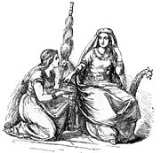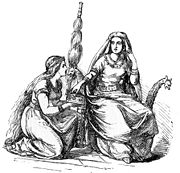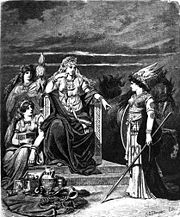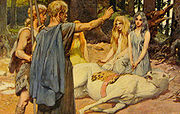
Fulla
Encyclopedia

Germanic paganism
Germanic paganism refers to the theology and religious practices of the Germanic peoples of north-western Europe from the Iron Age until their Christianization during the Medieval period...
, Fulla (Old Norse
Old Norse
Old Norse is a North Germanic language that was spoken by inhabitants of Scandinavia and inhabitants of their overseas settlements during the Viking Age, until about 1300....
, possibly "bountiful") or Volla (Old High German
Old High German
The term Old High German refers to the earliest stage of the German language and it conventionally covers the period from around 500 to 1050. Coherent written texts do not appear until the second half of the 8th century, and some treat the period before 750 as 'prehistoric' and date the start of...
) is a goddess. In Norse mythology
Norse mythology
Norse mythology, a subset of Germanic mythology, is the overall term for the myths, legends and beliefs about supernatural beings of Norse pagans. It flourished prior to the Christianization of Scandinavia, during the Early Middle Ages, and passed into Nordic folklore, with some aspects surviving...
, Fulla is described as wearing a golden snood
Snood (headgear)
A snood is historically a type of European female headgear, or in modern times a tubular neck scarf. In the most common form the headgear resembles a close-fitting hood worn over the back of the head...
and as tending to the ashen box and the footwear owned by the goddess Frigg
Frigg
Frigg is a major goddess in Norse paganism, a subset of Germanic paganism. She is said to be the wife of Odin, and is the "foremost among the goddesses" and the queen of Asgard. Frigg appears primarily in Norse mythological stories as a wife and a mother. She is also described as having the power...
, and, in addition, Frigg confides in Fulla her secrets. Fulla is attested in the Poetic Edda
Poetic Edda
The Poetic Edda is a collection of Old Norse poems primarily preserved in the Icelandic mediaeval manuscript Codex Regius. Along with Snorri Sturluson's Prose Edda, the Poetic Edda is the most important extant source on Norse mythology and Germanic heroic legends, and from the early 19th century...
, compiled in the 13th century from earlier traditional sources; the Prose Edda
Prose Edda
The Prose Edda, also known as the Younger Edda, Snorri's Edda or simply Edda, is an Icelandic collection of four sections interspersed with excerpts from earlier skaldic and Eddic poetry containing tales from Nordic mythology...
, written in the 13th century by Snorri Sturluson
Snorri Sturluson
Snorri Sturluson was an Icelandic historian, poet, and politician. He was twice elected lawspeaker at the Icelandic parliament, the Althing...
; and in skald
Skald
The skald was a member of a group of poets, whose courtly poetry is associated with the courts of Scandinavian and Icelandic leaders during the Viking Age, who composed and performed renditions of aspects of what we now characterise as Old Norse poetry .The most prevalent metre of skaldic poetry is...
ic poetry. Volla is attested in the "Horse Cure" Merseburg Incantation
Merseburg Incantations
The Merseburg Incantations are two medieval magic spells, charms or incantations, written in Old High German. They are the only known examples of Germanic pagan belief preserved in this language...
, recorded anonymously in the 10th century in Old High German
Old High German
The term Old High German refers to the earliest stage of the German language and it conventionally covers the period from around 500 to 1050. Coherent written texts do not appear until the second half of the 8th century, and some treat the period before 750 as 'prehistoric' and date the start of...
, in which she assists in healing the wounded foal
Foal
A foal is an equine, particularly a horse, that is one year old or younger. More specific terms are colt for a male foal and filly for a female foal, but these terms are used until the horse is age three or four. When the foal is nursing from its dam , it may also be called a suckling...
of Phol and is referred to as Frigg's sister. Scholars have proposed theories about the implications of the goddess.
Attestations

Poetic Edda
In the prose introduction to the Poetic Edda poem GrímnismálGrímnismál
Grímnismál is one of the mythological poems of the Poetic Edda. It is preserved in the Codex Regius manuscript and the AM 748 I 4to fragment. It is spoken through the voice of Grímnir, one of the many guises of the god Odin, who is tortured by King Geirröth...
, Frigg makes a wager with her husband—the god Odin
Odin
Odin is a major god in Norse mythology and the ruler of Asgard. Homologous with the Anglo-Saxon "Wōden" and the Old High German "Wotan", the name is descended from Proto-Germanic "*Wodanaz" or "*Wōđanaz"....
—over the hospitality of their human patrons. Frigg sends her servant maid Fulla to warn the king Geirröd—Frigg's patron—that a magician (actually Odin in disguise) will visit him. Fulla meets with Geirröd, gives the warning, and advises to him a means of detecting the magician:
- Henry Adams Bellows
Henry Adams BellowsHenry Adams Bellows was a lawyer, state legislator, and jurist born in Rockingham, Vermont. He was elected to the New Hampshire House of Representatives from Littleton, New Hampshire in 1839. He was subsequently elected again to the House from Concord, New Hampshire in 1856–1857, and served as...
translation:- Frigg sent her handmaiden, Fulla, to Geirröth. She bade the king beware lest a magician who was come thither to his land should bewitch him, and told this sign concerning him, that no dog was so fierce as to leap at him.
Benjamin Thorpe Benjamin ThorpeBenjamin Thorpe was an English scholar of Anglo-Saxon.-Biography:After studying for four years at Copenhagen University, under the Danish philologist Rasmus Christian Rask, he returned to England in 1830, and in 1832 published an English version of Caedmon's metrical paraphrase of portions of the...
translation:Frigg sent her waiting-maid Fulla to bid Geirröd be on his guard, lest the troll TrollA troll is a supernatural being in Norse mythology and Scandinavian folklore. In origin, the term troll was a generally negative synonym for a jötunn , a being in Norse mythology...
mann who was coming should do him harm, and also say that a token whereby he might be known was, that no dog, however fierce, would attack him.
Prose Edda
In chapter 35 of the Prose EddaProse Edda
The Prose Edda, also known as the Younger Edda, Snorri's Edda or simply Edda, is an Icelandic collection of four sections interspersed with excerpts from earlier skaldic and Eddic poetry containing tales from Nordic mythology...
book Gylfaginning
Gylfaginning
Gylfaginning, or the Tricking of Gylfi , is the first part of Snorri Sturluson's Prose Edda after Prologue. The Gylfaginning deals with the creation and destruction of the world of the Norse gods, and many other aspects of Norse mythology...
, High
High, Just-As-High, and Third
High, Just-As-High, and Third are three men that respond to questions posed by Gangleri in the Prose Edda book Gylfaginning...
provides brief descriptions of 16 ásynjur. High lists Fulla fifth, stating that, like the goddess Gefjun, Fulla is a virgin, wears her hair flowing freely with a gold band around her head. High describes that Fulla carries Frigg's eski, looks after Frigg's footwear, and that in Fulla Frigg confides secrets.
In chapter 49 of Gylfaginning, High details that, after the death of the deity couple Baldr and Nanna
Nanna
-Mythology:* Nanna or Sin , god of the moon in Sumerian mythology, also called Suen* Nanna , goddess and wife of the god Baldr in Norse mythology-People:* Nanna , a Scandinavian female name...
, the god Hermóðr
Hermóðr
Hermóðr the Brave is a figure in Norse mythology, the son of god Odin.-Prose Edda:Hermóðr appears distinctly in section 49 of the Prose Edda book Gylfaginning. There, it is described that the gods were speechless and devastated at the death of Baldr, unable to react due to their grief...
wagers for their return in the underworld location of Hel
Hel (realm)
In Norse mythology, Hel, the location, shares a name with Hel, a female figure associated with the location. In late Icelandic sources, varying descriptions of Hel are given and various figures are described as being buried with items that will facilitate their journey to Hel after their death...
. Hel
Hel (being)
In Norse mythology, Hel is a being who presides over a realm of the same name, where she receives a portion of the dead. Hel is attested in the Poetic Edda, compiled in the 13th century from earlier traditional sources, and the Prose Edda, written in the 13th century by Snorri Sturluson...
, ruler of the location of the same name, tells Hermóðr a way to resurrect Baldr, but will not allow Baldr and Nanna to leave until the deed is accomplished. Hel does, however, allow Baldr and Nanna to send gifts to the living; Baldr sends Odin the ring Draupnir
Draupnir
In Norse mythology, Draupnir is a gold ring possessed by the god Odin with the ability to multiply itself: Every ninth night eight new rings 'drip' from Draupnir, each one of the same size and weight as the original....
, and Nanna sends Frigg a robe of linen, and "other gifts." Of these "other gifts" sent, the only specific item that High mentions is a finger-ring for Fulla.
The first chapter of the Prose Edda book Skáldskaparmál
Skáldskaparmál
The second part of Snorri Sturluson's Prose Edda the Skáldskaparmál or "language of poetry" is effectively a dialogue between the Norse god of the sea, Ægir and Bragi, the god of poetry, in which both Norse mythology and discourse on the nature of poetry are intertwined...
, Fulla is listed among eight ásynjur who attend an evening drinking banquet held for Ægir
Ægir
Ægir is a sea giant, god of the ocean and king of the sea creatures in Norse mythology. He is also known for hosting elaborate parties for the gods.Ægir's servants are Fimafeng and Eldir.- Description :...
. In chapter 19 of Skáldskaparmál, poetic ways to refer to Frigg are given, one of which is by referring to her as "queen [...] of Fulla." In chapter 32, poetic expressions for gold
Gold
Gold is a chemical element with the symbol Au and an atomic number of 79. Gold is a dense, soft, shiny, malleable and ductile metal. Pure gold has a bright yellow color and luster traditionally considered attractive, which it maintains without oxidizing in air or water. Chemically, gold is a...
are given, one of which includes "Fulla's snood
Snood (headgear)
A snood is historically a type of European female headgear, or in modern times a tubular neck scarf. In the most common form the headgear resembles a close-fitting hood worn over the back of the head...
." In chapter 36, a work by the skald
Skald
The skald was a member of a group of poets, whose courtly poetry is associated with the courts of Scandinavian and Icelandic leaders during the Viking Age, who composed and performed renditions of aspects of what we now characterise as Old Norse poetry .The most prevalent metre of skaldic poetry is...
Eyvindr skáldaspillir
Eyvindr Skáldaspillir
Eyvindr Finnsson skáldaspillir was a 10th century Norwegian skald. He was the court poet of king Hákon the Good and earl Hákon of Hlaðir. His son Hárekr later became a prominent chieftain in Norway.His preserved works are:...
is cited that references Fulla's golden snood ("the falling sun [gold] of the plain [forehead] of Fulla's eyelashes shone on [...]"). Fulla receives a final mention in the Prose Edda in chapter 75, where Fulla appears within a list of 27 ásynjur names.
"Horse Cure" Merseburg Incantation

Merseburg Incantations
The Merseburg Incantations are two medieval magic spells, charms or incantations, written in Old High German. They are the only known examples of Germanic pagan belief preserved in this language...
(the "horse cure"), recorded in Old High German
Old High German
The term Old High German refers to the earliest stage of the German language and it conventionally covers the period from around 500 to 1050. Coherent written texts do not appear until the second half of the 8th century, and some treat the period before 750 as 'prehistoric' and date the start of...
, mentions Volla. The incantation describes how Phol and Wodan rode to a wood, and there Balder's foal
Foal
A foal is an equine, particularly a horse, that is one year old or younger. More specific terms are colt for a male foal and filly for a female foal, but these terms are used until the horse is age three or four. When the foal is nursing from its dam , it may also be called a suckling...
sprained its foot. Sinthgunt
Sinthgunt
Sinthgunt is a figure in Germanic mythology, attested solely in the Old High German 9th or 10th century "horse cure" Merseburg Incantation. In the incantation, Sinthgunt is referred to as the sister of the personified sun, Sunna , and the two sisters are cited as both producing charms to heal...
sang charms, her sister Sunna sang charms, Friia
Frigg
Frigg is a major goddess in Norse paganism, a subset of Germanic paganism. She is said to be the wife of Odin, and is the "foremost among the goddesses" and the queen of Asgard. Frigg appears primarily in Norse mythological stories as a wife and a mother. She is also described as having the power...
sang charms, her sister Volla sang charms, and finally Wodan sang charms, followed by a verse describing the healing of the foal's bone. The charm reads:
- Phol and Wodan went to the forest.
- Then Balder's horse sprained its foot.
- Then Sinthgunt sang charms, and Sunna her sister;
- Then Friia sang charms, and Volla her sister;
- Then Wodan sang charms, as he well could:
- be it bone-sprain, be it blood-sprain, be it limb-sprain:
- bone to bone, blood to blood,
- limb to limb, so be they glued together.
Theories
Andy Orchard comments that the seeming appearance of Baldr with Volla in the Merseburg Incantation is "intriguing" since Fulla is one of the three goddesses (the other two being Baldr's mother Frigg and his wife Nanna) the deceased Baldr expressly sends gifts to from Hel. John LindowJohn Lindow
John Lindow is a professor specializing in Scandinavian medieval studies and folklore at the University of California, Berkeley and author. Lindow's works include Norse Mythology: A Guide to the Gods, Rituals, and Beliefs, a handbook for Norse mythology...
says that since the name Fulla seems to have something to do with fullness, it may also point to an association with fertility.
Rudolf Simek
Rudolf Simek
Rudolf Simek is an Austrian Germanist and Philologian.Simek studied German literature, philosophy and Catholic theology in the University of Vienna, before becoming a librarian and a docent at the institution. He taught among others in the universities of Edinburgh, Tromsø and Sydney...
comments that while Snorri notes that Baldr sends Fulla a golden ring from Hel in Gylfaginning, "this does not prove that she plays any role in the Baldr myth, but merely shows that Snorri associated her with gold" because of kennings used associating Fulla with gold. Simek says that since Fulla appears in the poetry of Skalds as early as the 10th century that she was likely "not a late personification of plenty" but that she is very likely identical with Volla from the Merseburg Incantation. Simek adds that it is unclear as to who Fulla actually is; Simek says that she may be an independent deity or simply identical with the goddess Freyja or with Frigg.
John Knight Bostock says that theories have been proposed that the Fulla may at one time have been an aspect of Frigg. As a result, this notion has resulted in theory that a similar situation may have existed between the figures of the goddesses Sinthgunt and Sunna, in that the two may have been understood as aspects of one another rather than entirely separate figures.
Hilda Ellis Davidson states that the goddesses Gefjun, Gerðr, Fulla, and Skaði
Skaði
In Norse mythology, Skaði is a jötunn and goddess associated with bowhunting, skiing, winter, and mountains...
"may represent important goddesses of early times in the North, but little was remembered about them by the time Snorri was collecting his material." On the other hand, Davidson notes that it is also possible that these goddesses are viewable as aspects of a single Great Goddess
Great Goddess
Great Goddess refers to the concept of an almighty goddess, or to the concept of a mother goddess, including:*Great Goddess, anglicized form of the Latin Magna Dea*Great Goddess, anglicized form of the Sanskrit Mahadevi, the Shakti sum of all goddesses...
. Davidson calls Fulla and Volla "vague, uncertain figures, emerging from odd references to goddesses which Snorri has noted in the poets, but they suggest the possibility that at one time three generations were represented among the goddesses of fertility and harvest in Scandinavia."

